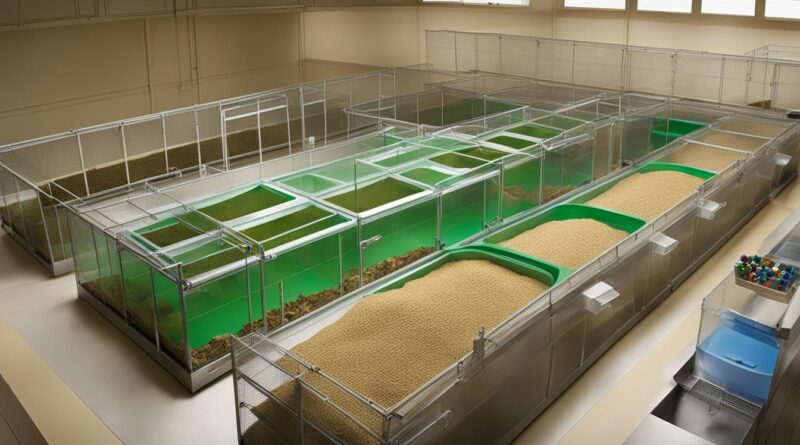The Challenges and Future of Hamster Breeding and Welfare
The journey of a hamster from a breeding facility to a warm, loving home is filled with numerous challenges that threaten the welfare of these endearing creatures. Addressing hamster breeding challenges is crucial for ensuring that these small pets are born and raised in conditions that reflect responsible and ethical hamster breeding practices. As hamsters continue to captivate hearts around the world, the onus falls on breeders, veterinary professionals, and pet owners alike to enhance pet hamster care standards.
Today, the future of hamster welfare hinges on our ability to integrate compassion with science. It’s about charting a path that promotes not just their survival but their well-being—calling for improvements in habitat, diet, and the prevention of prevalent diseases. A commitment to improving hamster longevity speaks volumes about our dedication to these pets as sentient beings who deserve a life full of vigor and comfort. Let us delve into how we can collectively raise the bar for hamster welfare and set a new paradigm in the pet industry.
Key Takeaways
- Understanding and overcoming hamster breeding challenges is essential for the health and welfare of these pets.
- Implementing ethical hamster breeding practices ensures the well-being of hamsters from birth.
- Enhanced pet hamster care contributes significantly to longer and more fulfilling lives for these animals.
- Future efforts in hamster welfare must focus on responsible ownership and compassionate care strategies.
- Research and awareness are key drivers in improving hamster longevity and quality of life.
Understanding the Popularity and Types of Pet Hamsters
The allure of keeping hamsters as pets lies in their charming personalities and ease of care, making them favorites among both young and adult pet enthusiasts. The United Kingdom, in particular, has observed a significant spike in pet hamster demographics, reflecting the country’s fondness for these cuddly, furry companions.
Popular pet hamsters come in a range of species, each with its own distinctive traits and care requirements. Syrian hamsters, known for their docile nature and solitary preference, have captivated hearts as the quintessential pet hamster. Meanwhile, the realm of dwarf hamster species offers a variety of choices, including the agile Djungarian and the swift-footed Roborovski hamsters.
An informed pet owner is one who understands not just the general appeal but also the specific needs of their furry family members. Across the UK, the range of hamster breeds available can feel overwhelming, but with the right knowledge, future hamster owners can make educated decisions in selecting a pet that aligns with their lifestyle and capabilities. To capture the heart of the phenomenon, let’s delve into a comparative overview of popular pet hamster breeds:
| Hamster Breed | Size | Personality | Lifespan | Care Level |
|---|---|---|---|---|
| Syrian Hamster | 5 to 7 inches | Docile, Solitary | 2 to 3 years | Low |
| Djungarian Hamster | 3 to 4 inches | Social, Active | 1.5 to 2 years | Moderate |
| Roborovski Hamster | 2 to 3 inches | Enigmatic, Fast | 3 to 3.5 years | High |
From Syrian hamsters to the delightful dwarf varieties, each breed presents a unique consortium of traits, such as the sociability of the Djungarian or the vivacity of the Roborovski. It’s crucial for enthusiasts to ponder these aspects when considering which type to take into their care. Ultimately, the right choice contributes to the richness of pet hamster demographics, enriching the pet-owning experience astronomically.
- When weighing options, consider Syrian hamsters for a more individual petting experience.
- If space is limited, the compact sizes of dwarf hamster species could be appealing.
- Preparedness for the commitment is key, as different breeds may require varying care levels.
Whether destined for a child’s playful interaction or an adult’s calm companionship, popular pet hamsters are more than just animals; they are gateways to enrichment, joy, and understanding in the miniature form of pet ownership. Pumping vitality into the pet industry, these endlessly fascinating creatures continue to garner intrigue with their diversity, taking an undeniable place in the homes and hearts across the UK and beyond.
Diving Into the Health Issues of Pet Hamsters
Within the cozy bedding and the spinning wheels of a hamster’s habitat lies a world less visible to the caring eye – the realm of pet hamster health. Proper understanding and management of common hamster disorders are essential for ensuring that your furry companion thrives. From monitoring for hamster illness signs to applying pet hamster care tips, each step is pivotal in nurturing a healthy pet.
Unfortunately, common ailments such as wet tail and hamster enteropathy frequently punctuate the lives of these small rodents, while their propensity to develop dental issues and injuries from skirmishes with cage mates underscores the importance of vigilant care. Let’s explore these health challenges that may lurk in hamster homes and learn how to counteract them effectively.
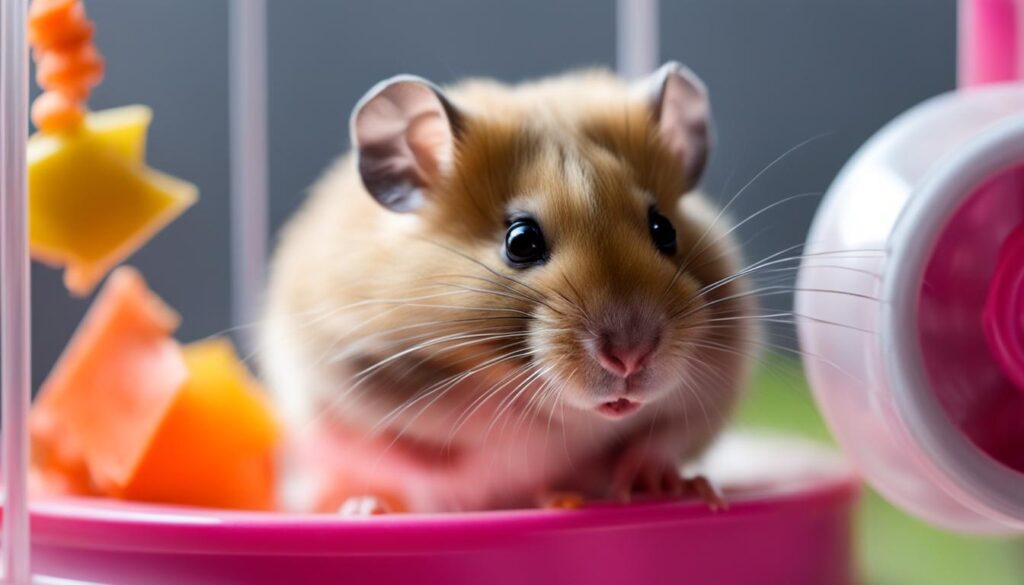
Most Common Health Disorders in Hamsters
It’s not just their endearing eyes or their penchant for nocturnal escapades that make hamsters special; it’s their resilient yet delicate health that requires attention. One infamous ailment affecting them is called wet tail, a form of hamster enteropathy that can wreak havoc on their digestive systems. Also plaguing these creatures are dental afflictions, like overgrown incisors and nails, which can impede their ability to enjoy their daily nibble and scurry.
The Impact of Breeding on Hamster Health
The gentle hum of a hamster wheel hides a deeper issue – the hamster breeding health impact. Breeding, not just for cuddly appeal but for robust health, is indeed a moral and practical obligation. Without ethical consideration, breeding for certain physical traits can inadvertently introduce genetic disorders in hamsters, turning a furry fantasy into a cautionary tale. Thus, ethical breeding practices serve as a compass, guiding our journey toward a future of flourishing, genetically sound critters.
Recognizing Early Signs of Illness
Being attuned to the silent language of hamsters could mean the difference between early recovery and prolonged illness. Due to their instinct to mask vulnerabilities, early detection of hamster diseases is a skill akin to deciphering a secret code penned by nature. Spotting the subtle indicators—lethargy, fur loss, or changes in eating habits—becomes a life-saving literacy in the world of pet hamster health. Awareness and prompt response to these hamster illness signs not only alleviate the immediate distress but can significantly extend the merry meanderings of these beloved pocket pets.
Whether you’re a seasoned hamster handler or new to the realm of rodent companionship, staying informed and vigilant about these health concerns will lead to happier, healthier whisker-twitching adventures. Dive into the wealth of knowledge on pet hamster care tips to arm yourself against the unseen adversaries of hamster well-being and gift your pet the bliss of good health it deserves.
The Ethical Considerations in Hamster Breeding
The conversation around ethical hamster breeding is intricate and multi-faceted, encompassing not just the physical well-being of these creatures but also their psychological health. The crux of the problem lies in the breeding practices that sometimes overlook the necessity for a life worth living, beyond mere survival. A truly responsible pet breeding regime incorporates extensive measures to ensure the genetic, mental, and emotional prosperity of hamsters.
For those involved in the breeding and distribution of these popular pets, assembling ethical paradigms is paramount. This includes shunning practices such as inbreeding, which while sometimes used to accentuate certain desirable traits, can also lead to a myriad of health issues and reduced genetic diversity. Instead, ethical breeding calls for a strategic and compassionate selection of breeding pairs, emphasizing the propagation of robust genetic lines that promise a healthier future for hamster populations worldwide.
Here, we outline key principles that exemplify animal welfare at the heart of hamster breeding:
- Transparency: Full disclosure of breeding conditions and practices to future pet owners and welfare agencies.
- Accountability: Breeders must be accountable for the health and welfare outcomes of their breeding programs.
- Sustainability: Breeding programs should focus on the long-term health and viability of hamster populations.
- Education: Continuous learning about the latest developments in rodent welfare and genetics for breeders.
- Compassion: At the core of all practices must be a genuine respect and care for the well-being of the hamsters.
Adhering to these principles is not just ethically sound; it also serves as a bedrock for responsible pet breeding. It cements a bond of trust between breeders, buyers, and the tiny beings at the center of it all – the hamsters themselves. Ethical breeding practices work in service of the larger goal of promoting a culture of respect and care for all creatures large and small, ultimately enhancing the reputation and success of the pet industry as a whole.
Hamster Breeding, Pet Industry, Animal Welfare
The pet industry standards stipulate a deep-rooted commitment to hamster welfare, a cause that reaches beyond mere commerce to touch upon the pillars of responsible pet ownership and animal compassion. Navigating this space requires a conscientious approach, infusing every aspect of hamster breeding with values that honor and advocate for the rights and dignities of these diminutive companions.
Navigating the Pet Industry’s Role in Hamster Welfare
In fostering hamster welfare, the pet industry wields the dual tools of education and advocacy, ensuring potential owners are well-versed in the nuances of hamster care. Industry players are called to elevate practices that manifest the utmost respect for animal health and contentment, correlating directly with responsible pet ownership.
The Intersection of Breeding Practices and Animal Rights
The variances in breeding practices impact hamster populations at a genetic core, interlocking the fields of animal husbandry and animal rights in the pet industry. Breeding that prioritizes genetic diversity and the eradication of debilitating traits forms a mosaic where the defense of animal rights and the nurturing of healthy lineage converge.
Setting the Standard for Ethical Breeding
Embarking on a quest to set exceptional hamster health standards leads us to the threshold of ethical breeding guidelines. These standards, woven from the threads of industry knowledge and compassion, help forge a path towards welfare-oriented breeding that sustains and enhances the esteemed lineage of domestic hamsters.
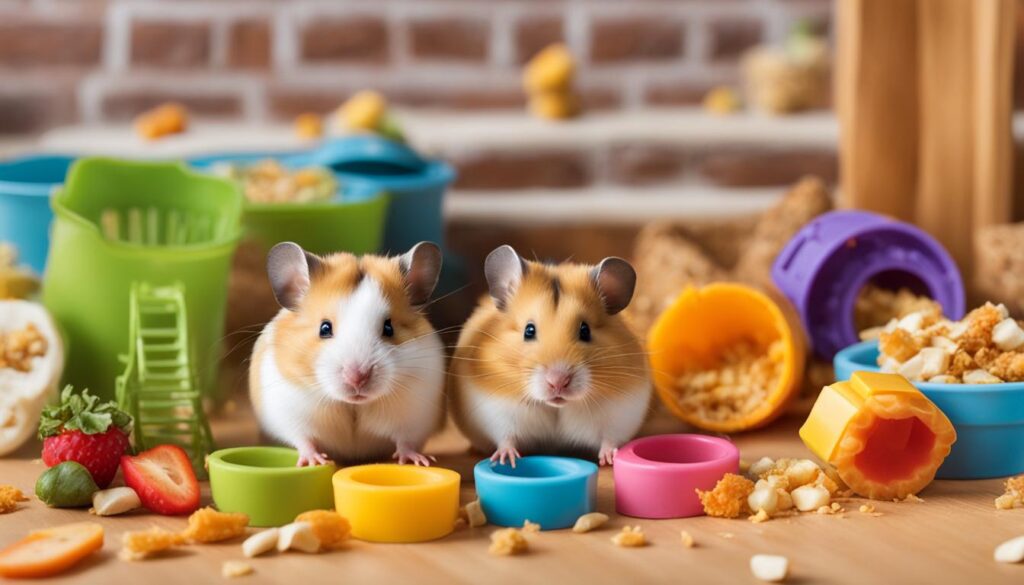
It is incumbent upon breeders and industry leaders to align with guidelines that embody scrutiny and a soft touch, a kinship with these agile creatures that ensures their genetic viability and happiness. Such a goal stands as a beacon for hamster genetic health, and by extension, a testament to humanity’s capacity for kindness within the fold of industry.
- Adopting a fulcrum of balance wherein economic goals do not outweigh the physiological and psychological needs of hamsters.
- Ensuring transparency and integrity by maintaining breeding facilities that reflect the industry’s commitment to animal welfare.
- Nurturing hamsters’ genetic health demands attention to meticulous breeding records, periodic health screenings, and strategic pairings.
- Turning the spotlight on responsible pet ownership, guiding consumers towards practices that enrich the lives of their hamster companions.
As the pet industry evolves, it finds itself enmeshed within the fabric of broader societal values, where the welfare of every creature, no matter how small, is a shared responsibility. It frames an opportunity to substantiate pet industry standards that reverence life, leading by example in the march towards a universally compassionate world.
Advancements in Veterinary Care for Hamsters
The landscape of veterinary care for hamsters is ever-evolving, with significant strides being made in areas ranging from disease detection in hamsters to hamster treatment advancements. These developments mark a pivotal shift towards elevating the health and welfare of these small, yet increasingly popular, exotic pets. Innovations in medical practices have not only revolutionized the approach to specialized hamster care but are also reshaping veterinarian education to better meet the needs of these unique animals.
Developments in Disease Detection and Treatment
Recent advancements in disease detection for hamsters have resulted in more accurate diagnoses, paving the way for targeted treatment options. This precision in identifying health issues is a cornerstone of modern veterinary medicine, one that underscores the advancements in hamster health research. Cutting-edge technologies and methods have improved the efficacy of treatments, enhancing the quality of life for these beloved pets.
Importance of Veterinary Training for Exotic Pets
The rising popularity of hamsters as pets has underscored the need for comprehensive exotic pets veterinary training. Vets are now seeking more specialized education to navigate the distinct aspects of hamster care. This specialized focus on veterinarian education ensures that practitioners are equipped with the knowledge and skills necessary to provide the highest standard of care for these tiny companions.
Contributions of Research to Hamster Well-being
Robust hamster welfare studies have contributed greatly to the body of knowledge surrounding hamster care. Veterinary science contributions have helped build a foundation of research that informs best practices. This evidence-based approach aids in creating optimal living environments and care standards that promote not only the physical health but also the psychological well-being of hamsters.
In conclusion, the synergy between ongoing research, updated veterinary practices, and specialized training programs is crafting a new era in veterinary care for hamsters. As we continue to unveil the complexities of hamster health, veterinarians are better prepared to affect positive outcomes, ensuring that these small pets receive the large scale care they truly deserve.
Influencing Factors on Hamster Mortality Rates
Understanding hamster mortality rates is critical in providing the best care for these small pets. Observations from recent studies give us valuable insights into the most prevalent causes of death in hamsters, guiding owners and veterinary professionals in crafting health strategies aimed at extending hamster lifespan.
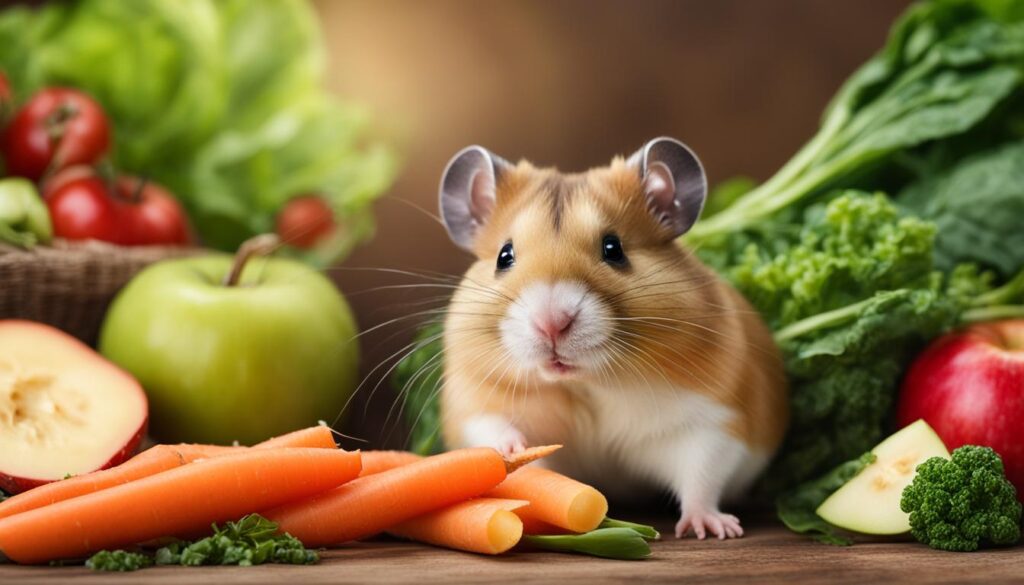
Analyzing Causes of Death among Domestic Hamsters
Research into domestic hamster populations has illuminated distressing conditions such as wet tail, characterized by diarrhea and high mortality if untreated, and neoplasia, a form of cancer that is becoming increasingly common in aged hamsters. Another significant concern is the occurrence of abdominal masses which can signal a range of issues from benign cysts to severe malignancies. By recognizing these conditions as leading causes of death in hamsters, caretakers can better anticipate and address health concerns that may arise.
Improving Hamster Longevity through Proper Care
Effective strategies in preventing common health issues in hamsters include providing a clean and spacious habitat, ensuring a balanced diet, and minimizing stress-inducing conditions. Regular veterinary check-ups contribute to the early detection and treatment of health problems, thus extending hamster lifespan. Additionally, fostering environmental enrichment through toys and exercise opportunities encourages mental stimulation, which is a fundamental aspect of proper hamster care. By embracing these practices, pet owners can offer their hamsters a chance at not only a longer life but a quality life as well.
Cultivating High Standards in the Breeding Environment
At the heart of quality hamster breeding lies a crucial element that often determines the well-being of these small mammals: the breeding environment standards. It’s essential for breeders to nurture an environment that meticulously adheres to the needs of these creatures. With a surge in pet ownership, the responsibility of fostering a welfare-centric breeding facility has never been more significant. The pedigree of a happy and healthy hamster is not just intrinsically linked to its genetic lineage, but equally to the caliber of its upbringing.
In the quest for quality hamster breeding, professionals must embrace a holistic approach that extends beyond the basics of shelter and sustenance. A comprehensive breeding environment includes ample space for play, exploration, and rest, ensuring physical well-being goes hand in hand with psychological health. Nutrition plays a pivotal role as well, with diets curated to support growth and vitality. Moreover, enrichment activities promote natural behaviors, offering sensory stimulation that is essential for cognitive development.
To embody the ideals of a welfare-centric breeding facility, social interactions can’t be overlooked. Hamsters, despite their often solitary nature, benefit immensely from environments that respect their social hierarchy and territorial instincts. Breeding professionals stand at the forefront of integrating these elements, paving the way for generations of hamsters that are not only physically robust but also emotionally balanced.
- Space vital for exercise and comfort
- Nutrition tailored to developmental stages
- Enrichment for behavioral encouragement
- Social consideration for harmonious cohabitation
By championing breeding environment standards that are attuned to the intricate needs of hamsters, breeders can make a profound impact. This dedication to excellence spawns a legacy of quality care that resonates with compassionate owners and happy, healthy hamsters alike, ultimately reflecting the earnest commitment of the breeding community to animal welfare.
Addressing Genetic Challenges in Hamster Breeding
Responsible hamster breeding necessitates a proactive approach to maintaining the genetic health of hamsters. The perpetual cycle of life within these creatures can be tarnished by a lack of genetic diversity, leading to significant health challenges. As such, understanding and mitigating hamster inbreeding consequences has become an essential aspect of ethical breeding practices.
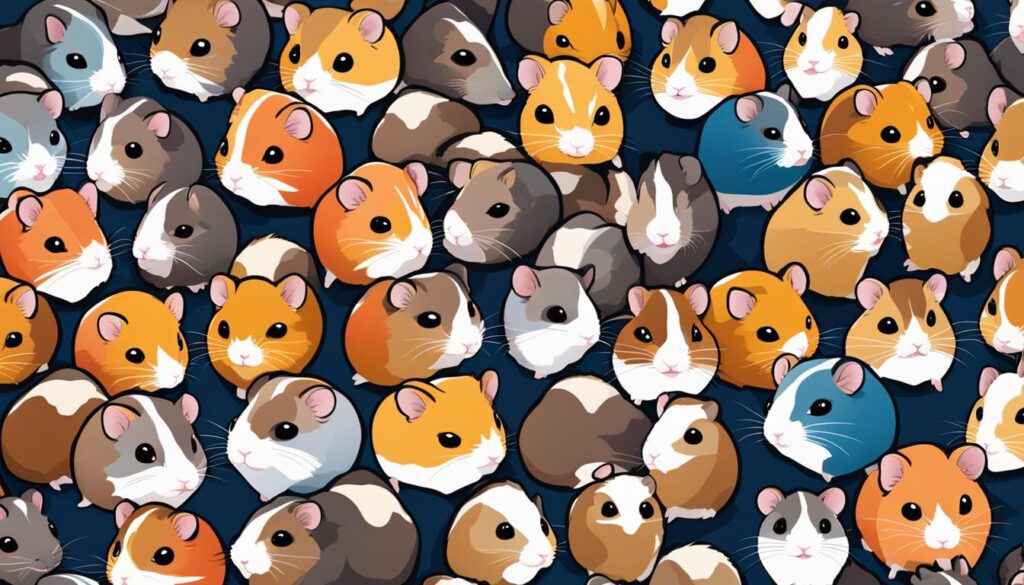
Consequences of Inbreeding and Genetic Diversity
Inbreeding, the practice of breeding individuals closely related genetically, can result in a plethora of undesirable outcomes. Among these is the rise in hamster genetic disorders, which may manifest as increased susceptibility to illnesses or specific hereditary health conditions. The concentration of harmful alleles within a population compromises not just the health of individual hamsters but can also undermine the vitality of entire colonies. This underscores the critical importance of promoting genetic diversity in breeding, which serves as a preventative measure against the aggregation of genetic defects and the erosion of population resilience over time.
Approaches to Reducing Genetic Disorders
Combatting genetic issues in hamster populations requires strategic hamster breeding strategies focused on genetic health improvement. These strategies include:
- Outbreeding: Mating hamsters from unrelated genetic lines to infuse genetic diversity and vitality.
- Cross-breeding: Combining varied breeds or strains to produce offspring endowed with a broader genetic makeup.
- Genetic Screening: Utilizing technological advancements to identify carriers of potential genetic disorders, leading to more informed breeding decisions.
Implementing such approaches is conducive to reducing hamster genetic disorders, fostering healthier and more robust hamster communities. Breeding must be informed by comprehensive data and ethically aligned with the welfare of the animals, contributing to a sustainable future for both the hamsters and the pet industry. Tailoring these efforts to the intricate dynamics of hamster genetics will steer breeding programs toward success and set a precedent for responsible animal stewardship.
Exploring Sustainable and Humane Breeding Techniques
In the pursuit of enhancing pet welfare, there is a nurturing shift towards sustainable hamster breeding, humane breeding practices, and responsible hamster production. These practices prioritize not only the well-being of these small pets but also seek to minimize the environmental footprint of breeding operations. In doing so, breeders contribute to a more compassionate and ecologically responsible pet industry.
When we talk about sustainable breeding techniques, we’re referring to methods that meet current demands for pets without compromising future populations. This includes ensuring genetic diversity, optimal living conditions, and mindful program development that supports hamster health and happiness for years to come. Humane breeding practices go hand in hand with sustainability, requiring a foundational understanding of each creature’s biological and psychological needs.
In this context, responsible hamster production is the active application of ethical practices in breeding facilities—practices that ensure hamsters are given a life worth living from the moment they are born. A breeding environment that offers ample space, enriching activities, and proper social interactions lays the groundwork for raising hamsters whose welfare is visibly placed at the forefront.
Moving beyond the confines of traditional breeding, consideration is also given to alternative agricultural practices and habitat connectivity. These approaches enhance not only the survival rates of hamsters but also their ability to exhibit natural behaviors, which is essential to their overall well-being.
| Focus Area | Techniques | Benefits |
|---|---|---|
| Genetic Diversity | Crossbreeding, diverse gene pools | Reduces hereditary diseases, improves resilience |
| Lifecycle Well-being | Enriched habitats, social structure respect | Promotes natural behavior, reduces stress |
| Eco-Friendly Practices | Organic bedding, renewable energy | Minimizes carbon footprint, supports sustainability |
This move toward a more holistic view of hamster breeding necessitates collaboration and commitment across all levels of the pet industry. It challenges breeders to implement innovative and thoughtful care strategies, giving every hamster the best start to life while safeguarding our planet for future generations.
As societies grow increasingly attuned to the needs of animals and the environment, the importance of sustainable and humane breeding cannot be overstated. These practices are not just beneficial—they are essential for the continued success and respectability of the pet industry. They are the manifestation of a collective promise to do better by those we call our companions and to honor the natural world we all share.
Conclusion
As we turn our attention to the horizon of hamster welfare, we find a future ripe with possibility. Groundbreaking advancements in veterinary care, a fortitude for responsible pet industry practices, and the elevation of breeding protocols act as the cornerstones in constructing a more compassionate world for pet hamsters. These creatures, small as they may be, have sparked a collective endeavor towards improving hamster welfare that cannot be understated in its importance for the pet community.
Progress in the future of hamster breeding will be measured not by the volume of pets produced but by the quality of life granted to each individual hamster. Education for breeders, caregivers, and the public alike serves as the guiding light in this journey, ensuring that our furry companions are met with the tenderness and expertise they deserve. The synthesis of this knowledge, combined with responsible pet industry practices, stands to redefine what it means to be a caretaker in the animal realm.
In conclusion, the collective efforts of all involved—from breeders and veterinarians to pet owners—forge a path toward a promising future. A future wherein each hamster’s pitter-patter within its habitat echoes the strides we’ve made, and continues to make, in welfare advancements. This vision for the future is not merely a goal but a commitment—a commitment to nurture, to protect, and to cherish the well-being of our petite pals with every ounce of our capability.
FAQ
What are the main challenges facing hamster breeding today?
The main challenges in hamster breeding include managing genetic health issues, maintaining ethical breeding practices, and improving the longevity and welfare of the hamsters.
What does the future look like for hamster welfare?
The future of hamster welfare looks promising with an emphasis on ethical breeding, increased awareness about proper pet hamster care, and advancements in veterinary treatments.
Why are hamsters such popular pets?
Hamsters are popular because of their small size, generally docile nature, and the manageable care they require, making them appealing especially for people living in smaller living spaces.
What are the most common breed of pet hamsters?
The most common breed of pet hamsters is the Syrian hamster, also known as the golden hamster, followed by various dwarf hamster species like the Djungarian and Roborovski.
What are the common health disorders found in hamsters?
Common health disorders in hamsters include ‘wet tail’ (hamster enteropathy), bite wounds from other hamsters, dental problems, and undiagnosed conditions that often need veterinary attention.
How does breeding affect hamster health?
Breeding practices can significantly impact the health of hamsters, often leading to genetic disorders if not managed properly. Ethical breeding practices aim to enhance genetic health and prevent congenital conditions.
Why is it difficult to recognize early signs of illness in hamsters?
As prey animals, hamsters have evolved to hide signs of illness to avoid attracting predators. This makes it challenging for owners and veterinarians to detect health issues at an early stage.
What are the ethical considerations in hamster breeding?
Ethical considerations in hamster breeding involve ensuring the animals’ well-being is prioritized, avoiding inbreeding, and responsibly selecting traits to avoid health complications.
How does the pet industry influence hamster welfare?
The pet industry influences hamster welfare by setting and maintaining standards that promote responsible ownership, proper care, and advocacy for the ethical treatment of pet hamsters.
Why is veterinary training important for hamster care?
Veterinary training is crucial to ensure that professionals have the specialized knowledge and skills required to diagnose and treat unique health issues presented by small pets like hamsters.
What factors contribute to the mortality rates of pet hamsters?
Factors contributing to pet hamster mortality rates include diseases like wet tail, improper care, traumatic injuries, and genetic conditions that may lead to early death.
How can hamster longevity be improved?
Improving hamster longevity involves providing a proper diet, safe habitat, regular health checks, and preventing stress and common health issues through informed care.
What standards should a quality hamster breeding environment meet?
A quality hamster breeding environment should meet standards that include ample space, appropriate nutrition, enrichment opportunities, and conditions that align with their natural behavior.
How can inbreeding and genetic challenges be addressed in hamster breeding?
Addressing inbreeding and genetic challenges involves strategies like outcrossing to increase genetic diversity, genetic screening, and responsible breeding practices that prioritize the health of the hamster population.
What are the key elements of sustainable and humane hamster breeding techniques?
Sustainable and humane hamster breeding techniques take into account the animals’ welfare, environmental impacts, and the promotion of practices that do not exploit or harm the hamsters throughout the breeding process.

